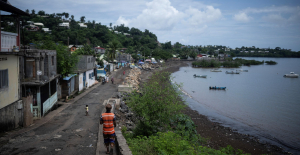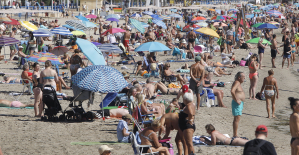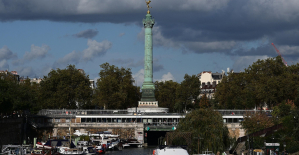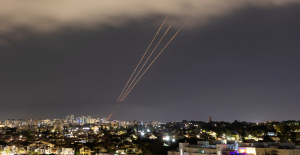North of the US state of Maine lies one of the most exciting regions in North America: New Brunswick (also: Nouveau-Brunswick) with the capital Fredericton. It's the only Canadian province where both French and English are official languages - traces of the two colonial powers that once fought over America's Northeast.
The French ruled first, and in 1763 their territory fell to the British crown. She divided the area, founded today's province in 1784 and named it New Brunswick (German: Neubraunschweig) in honor of King George III, who was also Elector of Brunswick-Lüneburg.
Despite historical and cultural sights, the region is best known for its spectacular nature. 240 kilometers of Atlantic coast score with the warmest saltwater beaches in Canada (up to 29 degrees water temperature thanks to a shallow sea basin on the coast), great water sports areas and opportunities to watch whales.
80 percent of the province is covered with forest, whose foliage attracts many tourists, especially in autumn. Foothills of the Appalachian Mountains characterize the west. In 32 nature parks you can hike, cycle, canoe or watch animals. There are also curiosities such as the Reversing Falls: At the rapids in the area where the Saint John River meets the Bay of Fundy, the direction of flow of the river reverses depending on the tides.
Reddish rocks, up to 21 meters high: The Hopewell Rocks are one of the natural wonders of the region. The force of the tides shaped the sandstone landscape at Hopewell Cape on the Bay of Fundy - the regular tidal range here reaches 14 metres, the highest in the world. And so the rock formation is under water twice a day, and the towers become islands.
On guided kayak tours you can explore the stone giants - and at low tide you can walk along the seabed. Locals also casually call the rock formation Flowerpot Rocks, as they are reminiscent of flower pots.
The first Europeans to reach New Brunswick's shores thought they were in Arcadia - this is one theory behind the name of the former French colony, Acadia. Their descendants call themselves Acadians to this day, they are known for their French-inspired cuisine and their dialect (Acadian French). At the Acadian Historical Village open-air museum, you can experience their history from 1770 to 1949, including period costumes.
People have inhabited New Brunswick since 7000 BC. The first Europeans encountered - in addition to other indigenous people such as the Mi'kmaq and Maliseet - the Passamaquoddy, who still live in New Brunswick and in the US state of Maine, at Passamaquoddy Bay, which is named after them. The name means something like "who hunt the pollack", which is a local fish. They have their own language and flag.
French Jesuits converted many Passamaquoddy to Catholicism in the 18th century and were allies of the French in the colonial wars against England. Today, despite an old peace treaty, the people are fighting for First Nation recognition and traditional land rights to the area around St Andrews, which they call Qonasqamkuk. There was once the main settlement of the Passamaquoddy with sacred tombs of their ancestors.
The first woman in the history of the British Empire to obtain a university degree studied in New Brunswick: Grace Annie Lockhart (1855–1916) received a Bachelor of Science and in English literature from Mount Allison University in 1875. Her performance was seen as proof that women too should have the skills to pursue higher education and should have equal access. The university is now considered one of the best in Canada.
The Confederation Bridge is 12.88 kilometers long. This makes the building, which opened in 1997, the longest bridge in Canada and one of the longest in the world. From New Brunswick you can reach Prince Edward Island, Canada's smallest province, whose license plate shows the bridge as a motif.
It spans the narrowest part of the Northumberland Strait, a strait. Its construction was a challenge due to the weather and cost around one billion Canadian dollars.
The world's largest potato (as its creators proudly call it) is in New Brunswick. Twenty feet tall, it advertises Harvey's Big Potato Farm in Maugerville. Potatoes are the most-produced crop in the region, where the climate and soil are ideal.
More than 250 varieties are cultivated on more than 20,000 hectares in New Brunswick, also by international players such as McCain, self-proclaimed "market leader in the field of frozen potato products". In Florenceville-Bristol you can visit the Potato World Hall of Recognition - the hall of honor of the potato world.
New Brunswick tubers are considered to be particularly tasty, and the local dishes should be tasted. For example poutine râpée, a modification of the Canadian national dish poutine. While the latter is a questionable mash of chips, cheese and gravy, the regional version is served as a meat-filled potato dumpling, a holiday staple of French-Acadian cuisine.
This article was first published in October 2021.
Bizarre, record-breaking, typical: You can find more parts of our regional geography series here.

 Gaza: under the spotlight, the Israeli-Palestinian conflict shakes up the Eurovision contest
Gaza: under the spotlight, the Israeli-Palestinian conflict shakes up the Eurovision contest Black soldier killed by a police officer in the United States: the sheriff publishes the video of the arrest
Black soldier killed by a police officer in the United States: the sheriff publishes the video of the arrest In Malmö, the Eurovision party transformed into entrenched camps
In Malmö, the Eurovision party transformed into entrenched camps In Russia, Vladimir Putin stigmatizes “Western elites”
In Russia, Vladimir Putin stigmatizes “Western elites” Fatal case of cholera in Mayotte: the epidemic is “contained”, assures the government
Fatal case of cholera in Mayotte: the epidemic is “contained”, assures the government The presence of blood in the urine, a warning sign of bladder cancer
The presence of blood in the urine, a warning sign of bladder cancer A baby whose mother smoked during pregnancy will age more quickly
A baby whose mother smoked during pregnancy will age more quickly The euro zone economy grows in April at its best pace in almost a year but inflationary pressure increases
The euro zone economy grows in April at its best pace in almost a year but inflationary pressure increases Artificial intelligence lies, cheats and deceives us, and that's a problem, experts warn
Artificial intelligence lies, cheats and deceives us, and that's a problem, experts warn Google Cloud mistakenly deletes UniSuper fund account and deprives 600,000 Australians of their superannuation
Google Cloud mistakenly deletes UniSuper fund account and deprives 600,000 Australians of their superannuation IBM, Amazon, Hager... These record investments expected at the Choose France summit
IBM, Amazon, Hager... These record investments expected at the Choose France summit Boeing's black streak: a second Air France flight diverted in three days for “a smell of heat”
Boeing's black streak: a second Air France flight diverted in three days for “a smell of heat” “I want to apologize”: Kendji Girac speaks for the first time since his injury
“I want to apologize”: Kendji Girac speaks for the first time since his injury Gollum at the heart of the next Lord of the Rings film and controversies
Gollum at the heart of the next Lord of the Rings film and controversies In Paris, the redevelopment of the squares between Bastille and the Saint-Martin canal displeases some residents
In Paris, the redevelopment of the squares between Bastille and the Saint-Martin canal displeases some residents Cate Blanchett in majesty at the San Sebastian Festival
Cate Blanchett in majesty at the San Sebastian Festival Omoda 7, another Chinese car that could be manufactured in Spain
Omoda 7, another Chinese car that could be manufactured in Spain BYD chooses CA Auto Bank as financial partner in Spain
BYD chooses CA Auto Bank as financial partner in Spain Tesla and Baidu sign key agreement to boost development of autonomous driving
Tesla and Baidu sign key agreement to boost development of autonomous driving Skoda Kodiaq 2024: a 'beast' plug-in hybrid SUV
Skoda Kodiaq 2024: a 'beast' plug-in hybrid SUV The home mortgage firm rises 3.8% in February and the average interest moderates to 3.33%
The home mortgage firm rises 3.8% in February and the average interest moderates to 3.33% This is how housing prices have changed in Spain in the last decade
This is how housing prices have changed in Spain in the last decade The home mortgage firm drops 10% in January and interest soars to 3.46%
The home mortgage firm drops 10% in January and interest soars to 3.46% The jewel of the Rocío de Nagüeles urbanization: a dream villa in Marbella
The jewel of the Rocío de Nagüeles urbanization: a dream villa in Marbella Diving into the secrets of the National Assembly
Diving into the secrets of the National Assembly Institutions: senators want to restore the accumulation of mandates and put an end to the automatic presence of ex-presidents on the Constitutional Council
Institutions: senators want to restore the accumulation of mandates and put an end to the automatic presence of ex-presidents on the Constitutional Council Europeans: David Lisnard expresses his “essential and vital” support for François-Xavier Bellamy
Europeans: David Lisnard expresses his “essential and vital” support for François-Xavier Bellamy Facing Jordan Bardella, the popularity match turns to Gabriel Attal’s advantage
Facing Jordan Bardella, the popularity match turns to Gabriel Attal’s advantage These French cities that will boycott the World Cup in Qatar
These French cities that will boycott the World Cup in Qatar Tennis: Djokovic knocked out by a gourd after his match in Rome (on video)
Tennis: Djokovic knocked out by a gourd after his match in Rome (on video) Handball: the Blues gently begin their Olympic preparation against the United States
Handball: the Blues gently begin their Olympic preparation against the United States WRC: Rovanperä leads the Rallye du Portugal ahead of Ogier
WRC: Rovanperä leads the Rallye du Portugal ahead of Ogier Ligue 2: Auxerre validates its return to Ligue 1 after a draw in Amiens
Ligue 2: Auxerre validates its return to Ligue 1 after a draw in Amiens


















